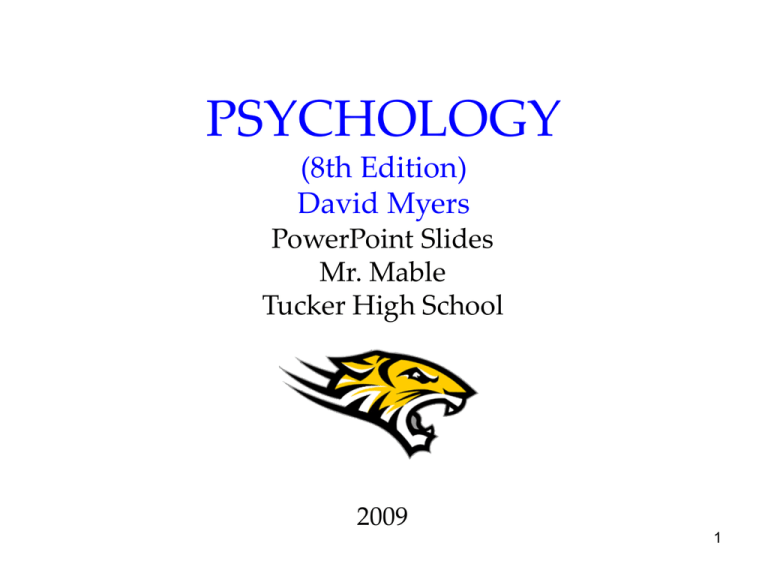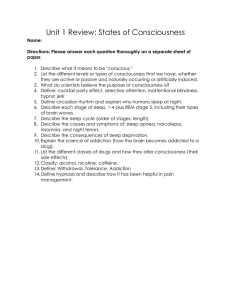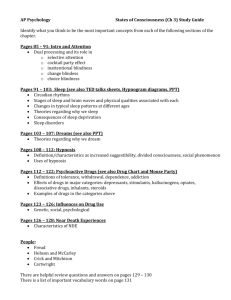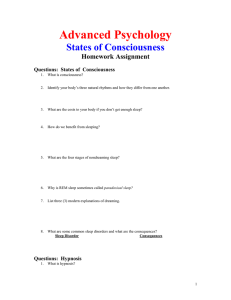
PSYCHOLOGY
(8th Edition)
David Myers
PowerPoint Slides
Mr. Mable
Tucker High School
2009
1
States of
Consciousness
Chapter 7
2
States of Consciousness
Consciousness and
Information Processing
Sleep and Dreams
Biological Rhythms
The Rhythm of Sleep
Sleep Disorders
Dreams
3
History of Consciousness
1. Psychology began as a science of
consciousness.
2. Behaviorists argued about alienating
consciousness from psychology.
3. However, after 1960, mental concepts
(consciousness) started reentering
psychology.
4
What is consciousness?
1. Environmental Awareness.
2. Direct Inner Awareness.
3. Unique Sense of Self.
4. A Sense of Time????
5
Forms of Consciousness
AP Photo/ Ricardo Mazalan
Stuart Franklin/ Magnum Photos
Christine Brune
Bill Ling/ Digital Vision/ Getty Images
Consciousness, modern psychologists believe, is
an awareness of ourselves and our environment.
6
Neuroscience & Consciousness
Neuroscientists believe that consciousness
emerges from the interaction of individual
brain events much like a chord that is created
from different musical notes.
7
Consciousness & Information
Processing
The unconscious mind processes information
simultaneously on multiple tracks, while the conscious
mind processes information sequentially.
Conscious mind
Unconscious mind
8
Conscious
Subconscious
Unconscious
9
10
Sleep & Dreams
Sleep – the irresistible tempter to whom we
inevitably succumb.
Mysteries about sleep and dreams have just started
unraveling in sleep laboratories around the world.
11
Biological Rhythms
Biological rhythms are controlled by
internal “biological clocks.”
1. Annual cycles: On an annual cycle, geese
migrate, grizzly bears hibernate, and humans
experience seasonal variations in appetite,
sleep, and mood. Seasonal Affective Disorder
(SAD) is a mood disorder people experience
during dark winter months.
12
Biological Rhythms
2. 28-day cycles: The
female menstrual
cycle averages 28
days. Research
shows menstruation
may not affect
moods.
13
Biological Rhythms
3. 24-hour cycles: Humans experience 24-hour
cycles of varying alertness (sleep), body
temperature, and growth hormone secretion.
4. 90-minute cycles: We go through various stages
of sleep in 90-minute cycles.
14
Rhythm of Sleep
Illustration © Cynthia Turner 2003
Circadian Rhythms occur on a 24-hour cycle and
include sleep and wakefulness, which are
disrupted during transcontinental flights.
Light triggers the suprachiasmatic nucleus to decrease
(morning) melatonin from the pineal gland
and increase (evening) it at night fall.
15
Sleep Stages
Measuring sleep: About every 90 minutes, we
pass through a cycle of five distinct sleep stages.
Hank Morgan/ Rainbow
16
Awake & Alert
During strong mental engagement, the brain
exhibits low amplitude and fast, irregular beta
waves (15-30 cps). An awake person involved in a
conversation shows beta activity.
Beta Waves
17
Awake but Relaxed
When an individual closes his eyes but remains
awake, his brain activity slows down to a large
amplitude and slow, regular alpha waves (9-14
cps). A meditating person exhibits an alpha brain
activity.
18
Sleep Stages 1-2
During early, light sleep (stages 1-2) the brain
enters a high-amplitude, slow, regular wave form
called theta waves (5-8 cps). A person who is
daydreaming shows theta activity.
Theta Waves
19
Sleep Stages 3-4
During deepest sleep (stages 3-4), brain activity
slows down. There are large-amplitude, slow
delta waves (1.5-4 cps).
20
Stage 5: REM Sleep
After reaching the deepest sleep stage (4), the
sleep cycle starts moving backward towards stage
1. Although still asleep, the brain engages in lowamplitude, fast and regular beta waves (15-40 cps)
much like awake-aroused state.
A person during this sleep exhibits
Rapid Eye Movements (REM)
and reports vivid dreams.
21
Stages of Sleep
22
90-Minute Cycles During Sleep
23
Why do we sleep?
We spend one-third of
our lives sleeping.
Jose Luis Pelaez, Inc./ Corbis
If an individual
remains awake for
several days, they
deteriorate in terms of
immune function,
concentration, and
accidents.
24
Sleep Deprivation
1. Fatigue and subsequent death.
2. Impaired concentration.
3. Emotional irritability.
4. Depressed immune system.
5. Greater vulnerability.
25
REM Rebound
• The tendency for REM sleep to increase
following REM sleep deprivation.
• What will happen if you don’t get a good
nights sleep for a week, and then sleep for
10 hours?
You will dream a lot.
26
Accidents
Frequency of accidents increase with loss of sleep
27
Sleep Theories
1. Sleep Protects: Sleeping in the darkness when
predators loomed about kept our ancestors out
of harm’s way.
2. Sleep Recuperates: Sleep helps restore and
repair brain tissue.
3. Sleep Helps Remembering: Sleep restores and
rebuilds our fading memories.
4. Sleep and Growth: During sleep, the pituitary
gland releases growth hormone. Older people
release less of this hormone and sleep less.
28
Sleep Disorders
narcolepsy
?
29
Insomnia
• Recurring problems in falling or staying asleep.
• Not your once in a while (I have a big test
tomorrow) having trouble getting to sleep
episodes.
• Insomnia is not defined by the number of hours
you sleep every night.
• Primary versus Secondary insomnia.
30
Narcolepsy
• Characterized by uncontrollable sleep
attacks.
•Lapses directly into REM sleep (usually
during times of stress or joy).
31
Sleep Apnea
• A sleep disorder
characterized by
temporary cessations
of breathing during
sleep and consequent
momentary
reawakenings.
• Usually accompanied
by loud snoring
32
Night Terrors
• A sleep disorder
characterized by high
arousal and an
appearance of being
terrified.
• Occur in Stage 4, not
REM, and are not often
remembered.
33
Sleepwalking
(Somnambulism)
• Sleepwalking is a sleep
disorder affecting an
estimated 10 percent of all
humans at least once in their
lives.
• Sleep walking most often
occurs during deep non-REM
sleep (stage 3 or stage 4
sleep) early in the night.
34
Sleepwalking
Symptoms and Features:
• Ambulation (walking or moving about) that occurs during
sleep. The onset typically occurs in pre-pubertal children.
• difficulty in arousing the patient during an episode
• amnesia following an episode
• episodes typically occur in the first third of the sleep
episode
• polysomnographic monitoring demonstrates the onset of
an episode during stage 3 or 4 sleep
• other medical and psychiatric disorders can be present
but do not account for the symptom
• the ambulation is not due to other sleep disorders such
as REM sleep behavior disorder or sleep terrors.
• Fatigue (which is not the same as drowsiness),
• stress and anxiety
35
Sleepwalking
• The sleep walking activity may include simply sitting up
and appearing awake while actually asleep, getting up
and walking around, or complex activities such as
moving furniture, going to the bathroom, dressing and
undressing, and similar activities. Some people even
drive a car while actually asleep. The episode can be
very brief (a few seconds or minutes) or can last for 30
minutes or longer.
• One common misconception is that a sleep walker
should not be awakened. It is not dangerous to awaken
a sleep walker, although it is common for the person to
be confused or disoriented for a short time on
awakening. Another misconception is that a person
cannot be injured when sleep walking. Actually, injuries
caused by such things as tripping and loss of balance
are common for sleep walkers.
36
Sleep Disorders: Insomnia
1. Somnambulism: Sleepwalking.
2. Insomnia: Difficulty falling asleep
3. Nightmares: Frightening dreams that wake
a sleeper from REM.
4. Night terrors: Sudden arousal from sleep
with intense fear accompanied by
physiological reactions (e.g., rapid heart
rate, perspiration) that occur during SWS.
37
Sleep Disorders: Insomnia
4. Narcolepsy: Overpowering urge to fall
asleep that may occur while talking or
standing up.
5. Sleep apnea: Failure to breathe when
asleep.
38
Dreams
The link between REM
sleep and dreaming
has opened up a new
era of dream research.
39
What do we Dream?
1. Negative Emotional Content: 8 out of 10
dreams have negative emotional content.
2. Failure Dreams: People commonly dream
about failure, being attacked, pursued,
rejected, or struck with misfortune.
3. Sexual Dreams: Contrary to our thinking,
sexual dreams are sparse. Sexual dreams in
men are 1 in 10; and in women 1 in 30.
4. Dreams of Gender: Women dream of men
and women equally; men dream more about
men than women.
40
Manifest vs Latent
• Manifest Content- remembered story line
of a dream( as distinct from its latent or
hidden content)
• Latent Content- according to Freud the
underlying meaning of a dream( as distinct
form its manifest content). Freud believed
that a dreams latent content functions as a
safety valve.
41
Why do we dream?
1. Wish Fulfillment: Sigmund Freud suggested
that dreams provide a psychic safety valve to
discharge unacceptable feelings. The dream’s
manifest (apparent) content may also have
symbolic meanings (latent content) that signify
our unacceptable feelings.
2. Information Processing: Dreams may help sift,
sort, and fix a day’s experiences in our
memories.
42
Why do we dream?
3. Physiological
Function: Dreams
provide the sleeping
brain with periodic
stimulation to
develop and preserve
neural pathways.
Neural networks of
newborns are quickly
developing; therefore,
they need more sleep.
43
Why do we dream?
4. Activation-Synthesis Theory: Suggests that the
brain engages in a lot of random neural
activity. Dreams make sense of this activity.
5. Cognitive Development: Some researchers
argue that we dream as a part of brain
maturation and cognitive development.
All dream researchers believe we need REM sleep. When
deprived of REM sleep and then allowed to sleep,
we show increased REM sleep called REM Rebound.
44
Dream Theories
Summary
45
States of Consciousness
Hypnosis
Facts and Falsehoods
Is Hypnosis an Altered State of
Consciousness?
Drugs and Consciousness
Dependence and Addiction
Psychoactive Drugs
Influences on Drug Use
46
Hypnosis
http://iddiokrysto.blog.excite.it
A social interaction in
which one person (the
hypnotist) suggests to
another (the subject)
that certain
perceptions, feelings,
thoughts, or behaviors
will spontaneously
occur.
Hypnos: Greek god of sleep
47
Mesmerism
http://www.general-anaesthesia.com
Credit for the popularity
of hypnosis goes to
Franz Anton Mesmer, a
physician, who
mistakenly thought he
discovered “animal
magnetism.” Some of his
patients experienced a
trancelike state and felt
better upon waking up.
Franz Mesmer (1734 - 1815)
48
Aspects of Hypnosis
1. Posthypnotic Suggestion: Suggestion carried
out after the subject is no longer hypnotized.
2. Posthypnotic Amnesia: Supposed inability to
recall what one experienced during hypnosis.
49
Hypnotic Feats
Strength, stamina, and perceptual and memory
abilities similarly affect those who are
hypnotized and those who are not
hypnotized.
50
Facts and Falsehood
Those who practice hypnosis agree that its power
resides in the subject’s openness to suggestion.
Can anyone experience hypnosis?
Yes, to some extent.
Can hypnosis enhance recall of
forgotten events?
No.
51
Facts and Falsehood
Can hypnosis force people to act
against their will?
No.
Can hypnosis be therapeutic?
Yes. Self-suggestion
can heal too.
Can hypnosis alleviate pain?
Yes. Lamaze can
do that too.
52
Is Hypnosis an Altered State of
Consciousness?
Courtesy of News and Publications Service, Stanford University
1. Social Influence Theory:
Hypnotic subjects may
simply be imaginative
actors playing a social
role.
2. Divided Consciousness
Theory: Hypnosis is a
special state of
dissociated (divided)
consciousness (Hilgard,
1986, 1992).
(Hilgard, 1992)
53
Mimi Forsyth
Both Theories
54
Drugs and Consciousness
Psychoactive Drug: A chemical substance that
alters perceptions and mood (effects
consciousness).
55
Dependence & Addiction
Continued use of a
psychoactive drug
produces tolerance.
With repeated
exposure to a drug,
the drug’s effect
lessens. Thus it takes
greater quantities to
get the desired effect.
56
Withdrawal & Dependence
1. Withdrawal: Upon stopping use of a drug
(after addiction), users may experience the
undesirable effects of withdrawal.
2. Dependence: Absence of a drug may lead to a
feeling of physical pain, intense cravings
(physical dependence), and negative emotions
(psychological dependence).
57
Misconceptions about Addiction
Addiction is a craving for a chemical substance,
despite its adverse consequences (physical &
psychological).
1. Addictive drugs quickly corrupt.
2. Addiction cannot be overcome voluntarily.
3. Addiction is no different than repetitive
pleasure-seeking behaviors.
58
Psychoactive Drugs
Psychoactive drugs are divided into four groups.
1.
2.
3.
4.
Depressants
Stimulants
Hallucinogens
Narcotics
59
Depressants
Depressants are drugs that reduce neural activity
and slow body functions. They include:
1. Alcohol
2. Barbiturates
3. Opiates
60
Physical vs Psychological
dependence
• Physical dependence- a physiological
need for a drug, marked by unpleasant
withdrawal symptoms when the drug is
discontinued
• Physical dependence- psychology need to
use a drug, such as to relieve negative
emotions
61
Psychoactive Drugs
• Depressants are drugs such as alcohol,
barbiturates (tranquilizer) and opiates that
calm neural activity and slow body
functions
62
Alcohol
1. Alcohol affects motor skills, judgment, and
memory…and increases aggressiveness while
reducing self awareness.
Ray Ng/ Time & Life Pictures/ Getty Images
Daniel Hommer, NIAAA, NIH, HHS
Drinking and Driving
63
Barbiturates
2. Barbiturates: Drugs that depress the activity of
the central nervous system, reducing anxiety
but impairing memory and judgment.
Nembutal, Seconal, and Amytal are some
examples.
64
Depressants
http://opioids.com/timeline
3. Opiates: Opium and its
derivatives (morphine
and heroin) depress
neural activity,
temporarily lessening
pain and anxiety. They
are highly addictive.
65
Stimulants
Stimulants are drugs that excite neural activity and
speed up body functions.
1.
2.
3.
4.
5.
6.
Caffeine
Nicotine
Cocaine
Ecstasy
Amphetamines
Methamphetamines
66
Caffeine & Nicotine
Caffeine and nicotine increase heart and
breathing rates and other autonomic functions to
provide energy.
http://office.microsoft.com/clipart
http://www.tech-res-intl.com
67
Amphetamines
Amphetamines stimulate neural activity, causing
accelerated body functions and associated energy
and mood changes, with devastating effects.
National Pictures/ Topham/ The Image Works
68
A Methamphetamine user
69
Ecstasy
Greg Smith/ AP Photos
Ecstasy or
Methylenedioxymethamphet
amine (MDMA) is a
stimulant and mild
hallucinogen. It produces a
euphoric high and can
damage serotonin-producing
neurons, which results in a
permanent deflation of mood
and impairment of memory.
70
Cocaine disrupts body process
71
The Effects of Ecstasy
72
Cocaine
Cocaine induces immediate euphoria followed by a crash.
Crack, a form of cocaine, can be smoked. Other forms of
cocaine can be sniffed or injected.
http://www.ohsinc.com
73
Hallucinogens
Ronald K. Siegel
Hallucinogens are
psychedelic (mindmanifesting) drugs that
distort perceptions and
evoke sensory images in
the absence of sensory
input.
74
Hallucinogens
Hemp Plant
http://static.howstuffworks.com
1. LSD: (lysergic acid diethylamide) powerful
hallucinogenic drug (ergot fungus) that is
also known as acid.
2. THC (delta-9-tetrahydrocannabinol): is the
major active ingredient in marijuana (hemp
plant) that triggers a variety of effects,
including mild hallucinations.
75
Drugs
Summary
76
Influences on Drug Use
The graph below shows the percentage of US highschool seniors reporting their use of alcohol,
marijuana, and cocaine from the 70s to the late 90s.
77
Influences on Drug Use
The use of drugs is based on biological,
psychological, and social-cultural influences.
78
Marijuana Use
The use of marijuana in teenagers is directly related
to the “perceived risk” involved with the drug.
79
States of Consciousness
Near-Death Experiences
80
Near-Death Experiences
(From “Hallucinations” by R.K. Siegel. Copyright
© 1977 Scientific American, Inc. All rights reserved.)
After a close brush with
death, many people
report an experience of
moving through a dark
tunnel with a light at the
end. Under the influence
of hallucinogens, others
report bright lights at
the center of their field
of vision.
81
82
Mind-Body Problem
Near-death experiences raise the mind-body issue.
Can the mind survive the dying body?
1. Dualism: Dualists believe that mind (nonphysical) and body (physical) are two distinct
entities that interact.
2. Monism: Monists believe that mind and body
are different aspects of the same thing.
83




